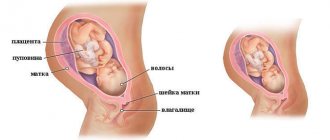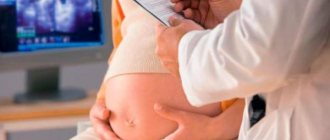Baby
At the 29th week of pregnancy, the baby continues to accumulate fat under the skin, folds and wrinkles are smoothed out, and, as a result, the skin becomes smoother. The body is still completely covered with vellus hair, the number of which at this stage decreases sharply. But hair growth on the head is activated. They become denser, darker and grow quickly. In the womb, the baby blinks frequently, moves less actively, and movements become less intense and frequent, but smoother. There is less and less space left in the uterus, so the child is most often in the same position, straightens his limbs, exposes his head and pelvic end. His height by this week is 36-37 cm, and his weight is 1,200-1,300 g. At this stage, the child is in a cephalic presentation, since his head is heavier than his buttocks. But there are often cases when in the water space at 29 weeks the baby is still in a breech position. The expectant mother should not worry about this, because there are still a few weeks for the baby to take the correct position. Otherwise, breech presentation will become one of the compelling reasons for choosing a method of delivery.
Medical procedures
Regular visits to the antenatal clinic are mandatory.
Regular urine samples for analysis before visiting the doctor have become a common procedure for you. Perhaps the doctor will also refer you for blood tests - general, biochemical, sugar levels, if there are any deviations in your health or previously identified health problems. During a routine examination, the doctor will perform the following manipulations:
- weigh the patient;
- measure blood pressure;
- determine the height of the uterine fundus, abdominal circumference;
- listen to the fetal heartbeat using a stethoscope;
- feels the abdomen to determine the location of the fetus;
- examine the limbs for swelling.
Ultrasound
In the ultrasound image, you can see the baby’s facial features.
At 32 weeks, you may be scheduled for a scheduled ultrasound of the third trimester, usually the last one before childbirth, if there are no pathologies. The next ultrasound can be performed at the perinatal center shortly before birth, if you arrive at the medical facility in advance. This procedure is mandatory, because it allows us to identify possible abnormalities in the development of the fetus and the condition of the mother’s reproductive organs, which may become the basis for a caesarean section. The following parameters are assessed:
- position of the fetus in the uterus;
- physical data of the fetus (circumference of the abdomen, head, length of the femur and humerus, etc.);
- weight and height;
- volume of amniotic fluid;
- structure and location of the placenta;
- cervical condition and others.
At the 32nd week, the baby can already take a position in the uterus that will remain until birth. The cephalic presentation (head down) is considered the most preferable and correct . If a breech presentation (legs down) is established, this may be the basis for a caesarean section within the prescribed time frame (normally after 37–38 weeks). However, there is still a chance that the baby will be able to roll over and take a position optimal for natural childbirth. To achieve this goal, the doctor may recommend that the woman perform special exercises and wear a prenatal bandage.
Doctors may also consider the option of surgical intervention in an upcoming birth if they determine that the fetus is large. If a woman has a narrow pelvis, giving birth naturally to a large fetus can be very problematic and can lead to problems for both mother and baby.
Doppler
Doppler measurements are performed during an ultrasound.
This procedure is necessary to assess the quality of blood flow and oxygen exchange between mother and baby. Usually performed immediately after an ultrasound in the third trimester, or on a regular basis if indicated. The abdomen is lubricated with gel and a sensor is installed. The condition of the blood vessels and the intensity of blood flow in the umbilical cord, placenta, and uterine arteries are checked using ultrasonic waves. The speed and pressure of circulating blood is also assessed, depending on the contraction and relaxation of the heart muscle.
Cardiotocography
To conduct cardiotocography, special
CTG sensors are applied to the abdomen (cardiotocography) - a procedure that determines the dependence of the fetal heartbeat on uterine contractions. CTG is usually prescribed for suspected fetal hypoxia or uterine hypertonicity, or for placental insufficiency. The procedure can be prescribed without good reason to check the quality of the fetal heart. The woman is placed on a couch and sensors are connected to her stomach. The mother is advised to lie still, and the procedure lasts 15–30 minutes. At the end of the CTG, the device produces a tape with a fetal heartbeat curve and other data; in appearance, the diagram resembles a familiar cardiogram.
Future mom
Women at 29 weeks of pregnancy still experience discomfort as the uterus continues to grow rapidly. This is especially felt by the organs that are located next to it - the bladder, stomach, and also the lower part of the large intestine. As the uterus grows, they shift and occupy a rather uncomfortable position, which can affect their work in the future. That is why at this time women often complain of a feeling of heaviness after eating and suffer from heartburn. Heartburn occurs as a consequence of stomach contents refluxing into the esophagus and is manifested by an unpleasant taste in the mouth, as well as a burning sensation inside. During pregnancy, the muscles that separate the esophagus from the stomach are heavily influenced by hormones and relax. This creates a similar situation. The rearranged position of the stomach only worsens the current situation. It is impossible to completely get rid of this condition. Of course, after giving birth this problem will solve itself, but in order to somehow help herself, a woman should eat often, but in small portions. It is important to chew your food thoroughly. These simple rules will help reduce the risk of heartburn after eating.
In addition, at week 29, expectant mothers notice increased urination, which in most cases will accompany them until childbirth. Frequent urge occurs due to rapidly progressive pressure on the bladder. False urges are also common during this period. These are situations when the bladder is not yet full, but the brain has already sent a signal about the need to urinate. In such cases, urination does not occur at all or occurs in a minimal amount. During pregnancy, frequent and completely painless urination is not a sign of any disease. However, if this process is accompanied by symptoms such as pain, the appearance of cloudy urine, you should immediately report this to your doctor, who will be able to determine the cause of these changes and exclude or confirm pyelonephritis.
Nutrition
Nutrition of a pregnant woman at 32 weeks
It is recommended to build proper nutrition for a pregnant woman at 32 weeks according to some rules:
- eat often, but not much. It is ideal to eat 5-6 times a day every 2-2.5 hours;
- stop eating until you feel full;
- do not mix different dishes at one meal;
- The last meal is 2-3 hours before bedtime. If necessary, you can curb your appetite with yogurt or fruit;
- drink about 1.5 liters of fluid per day, unless the gynecologist prescribes otherwise;
- exclude harmful foods, avoid semi-finished products, pickles, smoked foods, dried foods;
- completely avoid strong tea and coffee, unless otherwise prescribed by the gynecologist;
- consume a minimum of salt.
Following these recommendations can significantly reduce the manifestation of unpleasant sensations caused by the growth of the uterus: constipation, flatulence, heartburn.
To provide the fetus and your own body with the necessary nutrients, it is recommended to consume:
- red meat, offal, fish (preferably sea), daily;
- dairy products (cottage cheese, cheese, kefir);
- porridge (buckwheat, rice, oatmeal, etc.);
- chicken eggs (daily);
- vegetables and fruits (carrots, pumpkin, broccoli, asparagus, cauliflower, bananas, apples);
- dried fruits;
- berries.
Ideally, if you can include at least one of these products in your daily diet.
Vitamins
It is recommended to take multivitamin complexes and dietary supplements at the 32nd week of pregnancy strictly as prescribed by the gynecologist. You should not self-prescribe. To correctly determine the required dosage and the appropriate complex, the doctor evaluates the test results, the woman’s health status, takes into account regional characteristics and other factors.
It is worth remembering that an excess of certain elements can be no less harmful than their deficiency.
Baby
Week 30 is characterized by intensive growth in the baby’s muscle mass. He actively trains the muscles of the limbs, makes frequent movements, because during childbirth, all muscle groups of the arms, legs, chest, and back must be prepared. In the second stage of labor or during the immediate birth of a child, active contraction of the uterus and abdominal wall muscles occurs. The child makes movements independently. In this he is helped by the high tone of the body muscles, which significantly facilitates movement along the birth canal, and also allows for forward movements. Also this week, the preparation of the internal organs of the fetus for extrauterine life continues. The baby's chest is actively training, expanding and contracting. Such movements are very similar to breathing. The lungs are washed with amniotic fluid, and intensive production of surfactant continues. This substance ensures normal pulmonary respiration. The development of the alveoli can also be noted. These bubbles of lung tissue are necessary for gas exchange, because it is very important for the survival of the fetus to be ready for independent breathing during birth. It is worth noting that childbirth at the thirtieth week, which is due to any reasons, gives a high chance of independent breathing of the newborn, because the lung tissue is already mature and is quite ready to perform its functions.
The fetus actively swallows amniotic fluid, thereby contracting the gastrointestinal tract and stimulating the functioning of the liver and pancreas. The liver in the body of any person performs an important function, purifying the blood, and already at this stage of pregnancy is ready for full functioning. The formation of liver lobules is almost complete by the thirtieth week. Amniotic fluid constantly flows and stimulates the kidneys to intensively function: producing urine from the liquid part of the water. The daily rate of urine at this stage in a child can reach 0.5 liters.
Active work is also observed in the pancreas, which produces hormones and enzymes from the amniotic fluid. One of the most important is insulin. Potentially, already at this stage the pancreas is ready for full-fledged work and will be able to supply the newborn’s body with everything necessary.
Thus, at the thirtieth week, the internal organs of the fetus will be able to ensure its vital functions in the event of childbirth. Although their development actively continues until childbirth. The baby's height is 37-38 cm, and his body weight is about 1,300-1,400 g.
Future mom
At the thirtieth week, the expectant mother may experience active breast swelling, as well as the release of colostrum. This secretion of the mammary gland – “primary milk” – is quite thick and has a white or yellowish tint. The release of colostrum can occur at different times, everything is very individual, but most often it happens after the 30th week of pregnancy. If you find such discharge in yourself, this means that your body is actively preparing for the upcoming lactation. In the first few days after the birth of a child, colostrum from the woman’s body will be released very actively until breast milk appears.
During pregnancy, the fetus itself stimulates the production of colostrum. His adrenal glands produce a special hormone that, when interacting with placental hormones, activates the production of prolactin. Prolactin is a hormone from the mother's pituitary gland, which is responsible for milk production after childbirth.
At the 30th week of pregnancy, a woman receives a certificate of temporary incapacity for work, and also undergoes the procedure for registration of maternity leave, the duration of which is only 140 days.
What happens to the mother's body at 32 weeks of pregnancy
During pregnancy, you may experience some oral problems:
- Sensitive gums.
If your gums become more sensitive or they swell or bleed when you brush or floss, try rinsing your mouth with salt water and using a brush with as soft bristles as possible.
- The teeth seem to be loose.
Hormonal changes can cause ligaments, including the tiny ligaments that hold teeth in place, to relax. As these ligaments relax, the teeth may appear to become slightly loose. Don't worry: it is unlikely that you will actually lose a tooth; these sensations usually go away after childbirth.
- Stomatitis during pregnancy.
A characteristic symptom is the appearance of small wounds and ulcers in the mouth. Ulcers appear as a result of decreased immunity during pregnancy. After childbirth, the sores usually disappear.
Remember to floss daily, brush your teeth twice a day, and visit your dentist every six months. It is recommended that any elective dental procedures be performed in the first half of the third trimester (that is, now) if they were not performed in the second trimester. Your dentist may recommend postponing major dental procedures until after childbirth.
Baby
At 31 weeks of intrauterine life, the fetus weighs 1,500-1,600 g and has a height of 39-40 cm. This period is characterized by the continued development of the nervous system. The brain grows with high intensity, the convolutions deepen, and the surface area of the cortex increases. The brain, as well as its parts, thanks to nerve connections, function as one whole. The baby's periods of sleep and activity are already clearly alternating. Sleep, as before, takes up most of my time. It is worth noting that a child closes his eyes during sleep, and opens them during activity. The eyelids are so well developed that at this stage the fetus can already blink, open and close its eyes, squint and even squint. Exposure to bright light on the stomach causes the baby to close his eyes, which indicates a good level of development of his nervous system.
Future mom
By this time, the weight of the expectant mother increases by 7-8 kg. For pregnant women, it is important to monitor the rate of weight gain, because too much weight gain may indicate poor kidney function. So, per week the weight should increase by no more than 300-400 g. In addition, it is important to monitor the presence of swelling in the extremities and, if they are detected, notify the doctor. Fluid retention is a sign of pregnancy complications. Preeclampsia, which is also called late toxicosis, is characterized not only by swelling, but also by increased blood pressure, as well as the appearance of protein in the urine.
In the initial stages, gestosis can be completely asymptomatic, so a pregnant woman may not notice any changes at all and feel great. That is why it is important to constantly visit a doctor who can, based on tests, determine the presence of late toxicosis. Preeclampsia is one of the main causes of complications in both the mother and her child. It can provoke delayed fetal development, hypoxia, and negatively affect the functioning of the kidneys, vascular system and heart, as well as the woman’s liver.
Mild gestosis manifests itself in the form of edema. It can be corrected by normalizing water-salt metabolism. The doctor may prescribe special diets for the pregnant woman, as well as medications that will help cope with this condition.
Moderate or severe gestosis (nephropathy, preeclampsia and eclampsia) requires urgent hospitalization. Intensive therapy is provided in a hospital setting. Nephropathy in the expectant mother manifests itself not only in the form of edema, but also high blood pressure, as well as the appearance of protein in the urine, which is detected during tests.
Active progression of gestosis can cause severe nephropathy, which gradually develops into preeclampsia. This condition is manifested not only by edema, high blood pressure, protein in the urine, but also by circulatory disorders in the brain. Women report frequent dizziness, pain, as well as nausea, vomiting, and changes in reflexes.
Preeclampsia at its most severe stage (eclampsia) is characterized by the manifestation of convulsive seizures, which can cause coma. That is why it is important for a pregnant woman to detect signs of gestosis in the early stages in order to avoid an increase in symptoms, which in the future can lead to irreversible consequences.
Baby
This week of pregnancy is an important stage in the development of the fetus’s immunity, in the blood of which there is a sharp increase in its own immunoglobulins. These substances protect the child from infection. At the time of birth, the level of immunoglobulins will increase greatly due to the penetration of mother’s immunoglobulins into the child’s body. The last weeks of pregnancy are characterized by excellent permeability of the placental barrier, so protective cells from the mother’s body easily pass into the baby’s blood.
At this week of pregnancy, the child weighs about 1,700-1,800 g, and his body length is 41-42 cm. It is also worth noting that his facial features are approaching the appearance of a newborn, his face is rounded, wrinkles are smoothed out, and the hair on his head is actively growing. The even distribution of fat under the skin allows the baby to change skin color from bright red to pink.
The accumulation of subcutaneous fat is very important for thermogenesis. This process is necessary to constantly maintain body temperature at the same level. In an adult, these processes are controlled by special thermoregulation centers in the brain. At the time of birth, the child is not yet able to fully ensure thermoregulation, which is why the presence of subcutaneous fat is so important for him to maintain the required body temperature.
Future mom
The third trimester of pregnancy can be manifested by pain in the back, pubic area, as well as knee and hip joints. There may also be a feeling of bursting of the pelvic bones and pain. Such phenomena are present in many pregnant women, since the center of gravity changes and the spine shifts (due to the growth of the abdomen). At week 32, the woman’s body is already actively preparing, producing the placental hormone - relaxin, which is responsible for relaxing the ligaments, making the pelvis pliable during childbirth and thereby ensuring the easiest and most comfortable movement of the baby through the birth canal. Too much of this hormone causes pain and loosening of the ligaments. That is why pregnant women are recommended to undergo regular physical activity in the form of walking, yoga, fitness, and swimming. Strong muscles will be able to support the spine, and will also reduce discomfort in the lumbar region and pain. Doctors recommend that women wear a brace and sleep on their side to avoid significant stress on their back. Also, special devices (pillows, bolsters) will not be superfluous, which will allow the expectant mother to fully rest at night, take a comfortable position that will help relax the muscles of the back and legs.
What tests and examinations are needed?
Special examinations are no longer required. The doctor simply monitors the woman's condition.
Perhaps at this time a comparative test will be carried out to determine the condition of the fetus. The movements of the fetus, its breathing, heartbeat and the amount of amniotic fluid are examined. The rating scale for this study is two-point. Two points in all parameters - the fetus feels great. One point – his condition is satisfactory. A score of zero will require additional examinations and possibly hospitalization.









